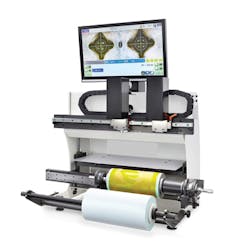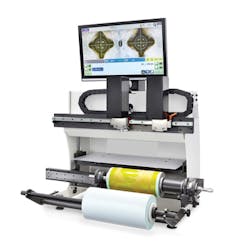High-speed imaging: Vision system upgrade improves printing plate alignment
Designed for fast, low-cost delivery of high-end printed graphics, flexographic presses are giant printing machines that can print on a variety of materials including paper, film and metal foil. This type of printing process uses flexible relief plates made of thin polymer sheets that have been coated with a photo-sensitive surface.
After being laser engraved with relief images of the digital artwork, these flexible printing plates get wrapped around a print cylinder and installed into the press. Each desired color on the printed material requires its own plate. Depending on the print job, there may be up to ten cylinders, one for each shade of color necessary.
During operation, the plates transfer the ink and print the artwork onto the passing web material. For clear, high-quality printing, the relief image on each plate must be aligned and properly registered with other images, print plates and print cylinders.
Because manual plate alignment is time consuming and error prone, the plate mounting process has become increasingly automated in recent years, and machine vision systems play a key role in reducing the time required for pre-press preparations and improving print quality.
To guarantee form stability, running accuracy and productivity without machine downtime, automated flexoprint mounting machines generally provide an integrated, vision system that monitors, manages and adjusts the registered alignment of the plate mounting based on reference points such as microdots or crosses on flexographic printing cylinders to ensure quality and high precision during the printing process.
When a leading Italian manufacturer of flexographic printing and mounting machines wanted to modernize the vision systems used in their equipment portfolio, they turned to imaging specialist FRAMOS (Taufkirchen, Germany and Ottawa, Canada; www.framos.com) to design a new high-speed, high-resolution imaging system. The new imaging systems had to meet four main requirements to increase the system performance, according to Lorenzo Cassano, head of the Framos camera business unit.
"First and most important was the need for high speed and high resolution cameras to meet the megapixel and frame rate demands of the application, along with fast digital interfaces for timely transmission of the large amount of process data generated," Cassano explains. "Second was the need to overlook a large field of interest from multiple points of view and to have full control to work with high-quality optical zooming from various distances. Next, the solution had to be flexible in terms of adjusting focus and zoom factor and, finally, had to be available at an affordable price."
After defining requirements, application parameters and conditions, it took the FRAMOS team three weeks to arrive at the final design solution (Figure 6). During the process, engineers not only had to specify the appropriate vision system components, but also built and tested custom prototypes and individual adaptions.
The FCB-EV7500 block camera from Sony Corp. (Tokyo, Japan; http://pro.sony.com/) was selected. Running a fast 2.4 MPixel Sony Exmor CMOS image sensor and a 30x optical zoom auto-focus lens, FRAMOS engineers determined that it delivered the high image quality needed in full HD and offered a dynamic range suitable for the application.
The corresponding external iPORT SB-GigE OEM frame grabber kit from Pleora Technologies (Kanata, ON, Canada; www.pleora.com), essentially transforms the Sony camera into a GigE Vision camera, Cassano notes. The interface is able to control the camera over a digital channel and to transmit full-resolution video at the maximum rate supported with low, predictable latency over a GigE link and GigE cable.
An M110 industrial PC from Tattile (Brescia, Italy; www.tattile.com) can run up to six cameras for multiple points of view, each one powered through Power over Ethernet (PoE), having a completely dedicated power channel for all the PoE devices and providing camera image streaming and full lens control.
The system transmits full-resolution images at the maximum rate supported by the block camera, supporting cable distances of up to 100 metres and featuring a low, predictable latency, according to Cassano. "This makes it possible to have complete control of the zoom and focus of each Sony block camera with only a single cable connection."

